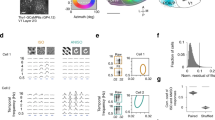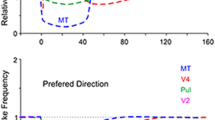Summary
The representation of the visual field in the middle temporal area (MT) was examined by recording from single neurons in anesthetized, immobilized macaques. Measurements of receptive field size, variability of receptive field position (scatter) and magnification factor were obtained within the representation of the central 25°. Over at least short distances (less than 3 mm), the visual field representation in MT is surprisingly orderly. Receptive field size increases as a linear function of eccentricity and is about ten times larger than in V1 at all eccentricities. Scatter in receptive field position at any point in the visual field representation is equal to about one-third of the receptive field size at that location, the same relationship that has been found in V1. Magnification factor in MT is only about onefifth that reported in V1 within the central 5° but appears to decline somewhat less steeply than in V1 with increasing eccentricity. Because the smaller magnification factor in MT relative to V1 is complemented by larger receptive field size and scatter, the point-image size (the diameter of the region of cortex activated by a single point in the visual field) is roughly comparable in the two areas. On the basis of these results, as well as on our previous finding that 180° of axis of stimulus motion in MT are represented in about the same amount of tissue as 180° of stimulus orientation in V1, we suggest that a stimulus at one point in the visual field activates at least as many functional “modules” in MT as in V1.
Similar content being viewed by others

References
Albright TD (1984) Direction and orientation selectivity of neurons in visual area MT of the macaque. J Neurophysiol 52: 1106–1130
Albright TD, Desimone R (1984) Precision of visuotopic organization of area MT in the macaque. Neurosci Abstr 10: 474
Albright TD, Desimone R, Gross CG (1981) Organization of directionally selective cells in area MT of macaques. Neurosci Abstr 7: 832
Albright TD, Desimone R, Gross CG (1984) Columnar organization of directionally selective cells in visual area MT of the macaque. J Neurophysiol 51: 16–31
Allman JM, Kaas JH (1971) A representation of the visual field in the caudal third of the middle temporal gyrus of the owl monkey (Aotus trivirgatus). Brain Res 31: 85–105
Baker JF, Petersen SE, Newsome WT, Allman JM (1981) Visual response properties of neurons in four extrastriate visual areas of the owl monkey (Aotus trivirgatus): a quantitative comparison of the medial, dorsomedial, dorsolateral, and middle temporal areas. J Neurophysiol 45: 397–416
Barlow HB, Blakemore C, Pettigrew JD (1967) The neural mechanism of binocular depth discrimination. J Physiol (Lond) 198: 327–342
Blasdel GG, Salama G (1986) Voltage sensitive dyes reveal a modular organization in monkey striate cortex. Nature 321: 579–585
Burkhalter A, Van Essen DC, Maunsell JHR (1981) Patterns of 2-deoxyglucose labeling in extrastriate visual cortex of unstimulated and unidirectionally stimulated macaque monkeys. Neurosci Abstr 7: 172
Daniel PM, Whitteridge D (1961) The representation of the visual field in the cerebral cortex in monkeys. J Physiol (Lond) 159: 302–321
Desimone R, Ungerleider LG (1986) Multiple visual areas in the caudal superior temporal sulcus of the macaque. J Comp Neurol 248: 164–189
Dow BM, Snyder AZ, Vautin RG, Bauer R (1981) Magnification factor and receptive field size in foveal striate cortex of the monkey. Exp Brain Res 44: 213–228
Dubner R, Zeki SM (1971) Response properties and receptive fields of cells in an anatomically defined region of the superior temporal sulcus in the monkey. Brain Res 35: 528–532
Gallyas F (1969) Silver staining of myelin by means of physical development. Orvostucomany 20: 433–489
Gattass R, Gross CG (1981) Visual topography of the striate projection zone in the posterior superior temporal sulcus (MT) of the macaque. J Neurophysiol 46: 621–637
Guld C, Bertulis A (1976) Representation of fovea in the striate cortex of vervet monkey, Cercopithecus aethiops pygerythrus. Vision Res 16: 629–631
Hubel DH, Wiesel TN (1963) Shape and arrangement of columns in cat's striate cortex. J Physiol (Lond) 165: 559–568
Hubel DH, Wiesel TN (1974a) Sequence regularity and geometry of orientation columns in the monkey striate cortex. J Comp Neurol 158: 267–294
Hubel DH, Wiesel TN (1974b) Uniformity of monkey striate cortex: a parallel relationship between field size, scatter and magnification factor. J Comp Neurol 158: 295–306
Livingstone MS, Hubel DH (1984) Anatomy and physiology of a color system in the primate visual cortex. J Neurosci 4: 309–356
Lund JS, Lund RD, Hendrickson AE, Bunt AH, Fuchs AF (1975) The origin of efferent pathways from the primary visual cortex, area 17, of the macaque monkey as shown by retrograde transport of horseradish peroxidase. J Comp Neurol 164: 287–304
Maunsell JHR, Van Essen DC (1983) Functional properties of neurons in middle temporal visual area of the macaque monkey. I. Selectivity for stimulus direction, speed, and orientation. J Neurophysiol 49: 1127–1147
Maunsell JHR, Van Essen DC (1986) The topographic organization of the middle temporal visual area in the macaque monkey and its relationship to callosal connections and myeloarchitectonic boundaries. (in press)
McIlwain JT (1976) Large receptive fields and spatial transformations in the visual system. Int Rev Physiol 10: 2563–2586
Moran J, Desimone R (1985) Selective attention gates visual processing in the extrastriate cortex. Science 229: 782–784
Mountcastle VB (1957) Modality and topographic properties of single neurons of cat's somatic sensory cortex. J Neurophysiol 20: 408–434
Schwartz EL (1980) Computational anatomy and functional architecture of striate cortex: a spatial mapping approach to perceptual coding. Vision Res 20: 645–669
Talbot SA, Marshall DW (1941) Physiological studies on neural mechanisms of visual localization and discrimination. Am J Ophthalmol 24: 1255–1263
Tootel RBH, Silverman MS, Switkes E, DeValois RL (1982) Deoxyglucose analysis of retinotopic organization in primate striate cortex. Science 218: 902–904
Ungerleider LG, Desimone R (1986a) Cortical connections of visual area MT in the macaque. J Comp Neurol 248: 190–222
Ungerleider LG, Desimone R (1986b) Projections to the superior temporal sulcus from the central and peripheral field representations of V1 and V2. J Comp Neurol 248: 147–163
Ungerleider L, Mishkin M (1979) The striate projection zone in the superior temporal sulcus of Macaca mulatta: location and topographic organization. J Comp Neurol 188: 347–366
Van Essen DC, Maunsell JHR, Bixby JL (1981) The middle temporal visual area in the macaque: myeloarchitecture, connections, functional properties and topographic organization. J Comp Neurol 199: 293–326
Van Essen DC, Newsome WT, Maunsell JHR (1984) The visual field representation in striate cortex of the macaque monkey: asymmetries, anisotropies, and individual variability. Vision Res 24: 429–448
Weller RE, Kaas JH (1983) Retinotopic patterns of connections of area 17 with visual areas V-II and MT in macaque monkeys. J Comp Neurol 220: 253–279
Zeki SM (1974) Functional organization of a visual area in the posterior bank of the superior temporal sulcus of the rhesus monkey. J Physiol (Lond) 236: 549–573
Author information
Authors and Affiliations
Rights and permissions
About this article
Cite this article
Albright, T.D., Desimone, R. Local precision of visuotopic organization in the middle temporal area (MT) of the macaque. Exp Brain Res 65, 582–592 (1987). https://doi.org/10.1007/BF00235981
Received:
Accepted:
Issue Date:
DOI: https://doi.org/10.1007/BF00235981



